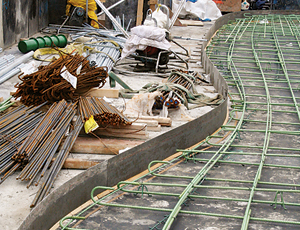He used to pour pints of stout in Ireland, but Paul Treacy found his true calling pouring concrete for James McHugh Construction Co.


Born in Wales and raised near Dublin, Treacy started working at the family pub at the tender age of 11. “I used to have a crate behind the bar so I could reach the taps,” says the 43 year-old. Looking for a change of venue as a young man, Treacy arrived in Chicago in 1986 with $100 in his pocket. Naturally, he wanted to tend bar, but at only 20 years old he would have to wait a year to apply.
So Treacy cut his teeth as a carpenter, working his way up the ladder of Chicago’s big-shoulders construction scene, eventually becoming a concrete superintendent and tackling some of the most difficult projects in the Windy City.
Treacy’s drive for innovation has brought new concrete technology to the Midwest skyline. He was one of the first superintendents in the U.S. to install an integrated plywood-and-steel windshield to formwork. Popular in Europe, that method has helped protect high-rise crews from falls and made them more productive.
Treacy has since moved on to more “edgy” challenges. When local architect Jeanne Gang designed Aqua, a hip, mixed-use skyscraper in the East Loop, she tasked McHugh with transforming the usual squared-off, boring concrete slabs of most high-rises into an 82-story stack of curvaceousness. Because each slab edge is unique in plan—the building appears to ripple in the breeze—McHugh had to invent a concrete form that could shape the complex floor edges but also control costs by being reusable, all the while enabling a proposed four-day pour cycle.

Irish-born superintendent framed the cutting edge of concrete construction techniques for Chicago’s trendy, up-and-coming Aqua building.
Working for Aqua owner Magellan Development Group, the contractor decided to tap its crew for ideas. Treacy went to work with his team, drawing plans and mocking up prototypes before settling on a light-gauge, flexible steel sheet. A total station lays out the shapes, and brackets welded to the flexible form allow workers to nail it to horizontal flying forms. The vertical edge forms handle infinite shapes, then pop back straight when removed. Almost topped out at the 73rd floor, Treacy’s crew has beat its own goal with a three-day pour cycle per floor.
Treacy had asked vendors for help and even flew to Las Vegas to the World of Concrete in search of advice. “Every company I talked to had small bits to say,” he says. “Right from the get-go, I knew it was going to be something that’s pliable and something you can change out very easily.” Some vendors suggested using a form secured with bolts, but Treacy knew that would suck up valuable time. Returning empty-handed, Treacy and his crew became inventors, testing mock-ups using three different, custom-made slab forms until they found the right cocktail. It now “works like a charm,” he says.
The solution was crucial to making Gang’s wild design possible and helping to usher Chicago’s cutting-edge skyscraper legacy into a new era. “We’re very happy so far with how the building is taking shape,” Gang says. Aqua is due to open later this year.


Post a comment to this article
Report Abusive Comment